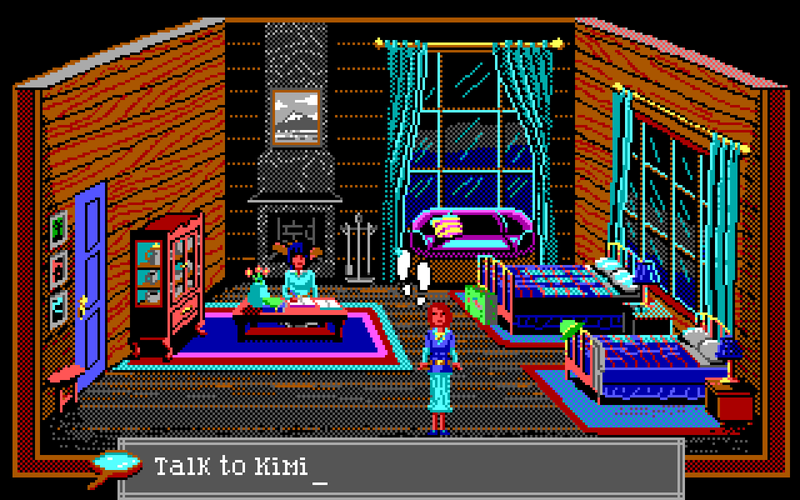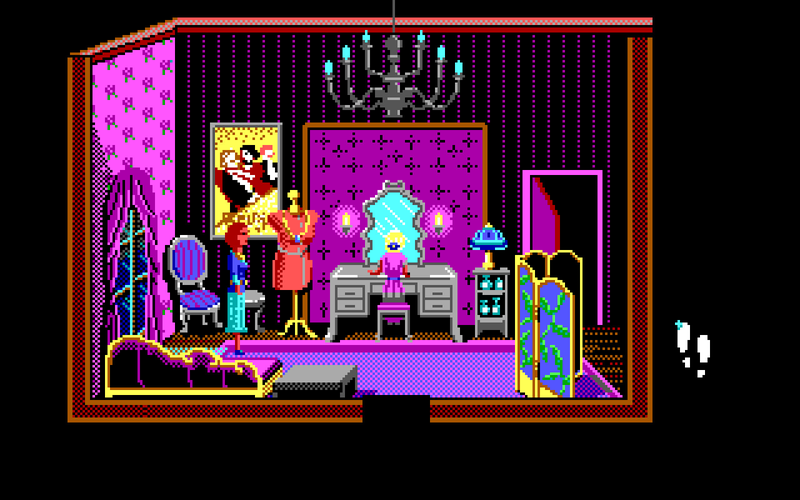It’s 1913 and young Nancy Maple, an amateur geologist, travels from Toronto to the remote Canadian town of Crimson to investigate the discovery of a large diamond. However, things are more perilous than they initially seem, and before long our plucky heroine finds herself investigating an apparent murder instead. Released on August 15, The Crimson Diamond is a brand-new adventure game from developer Julia Minamata, and it is exceptional. With its design, Minamata excavates a once-common element of early adventure games that has long fallen by the wayside, dismissed as if it were no longer of any value. However, The Crimson Diamond brilliantly demonstrates that, when used effectively, this device can actually enhance our connection to a game. Let me explain.
When you think of adventure games, chances are you think of point-and-clicks, games in which all of your interactions with other characters and the environment are done by clicking. Whether you click on verbs in the lower part of the screen as in early SCUMM games or have more minimal interfaces like many adventure games since the mid-90s, the game is designed so that every interaction can be navigated and every puzzle can be solved with nothing but a few clicks of the mouse. This style of play became so common that the term “point-and-click adventure games” practically became synonymous with adventure games as a whole. However, once upon a time there were many great adventure games that you interacted with through a text parser, typing in specifically what you wanted your character to do. The Crimson Diamond brings this back, and uses it to brilliant effect.
In defense of text parsers
Now, I think some see text parsers as outdated, a necessity of early adventure games that was largely abandoned when something “better” was devised. However, I’ve often thought that if a game is designed intentionally to make good use of a text parser, it can really open up the possibilities for ways in which you can think about interacting with the world and the situations the game presents you with. I’ll give you one example from my own memory. When I was young, I played the brilliant Sierra game Space Quest 2. A 1987 release, this game saw Sierra still very much in its text parser era, and at one point, I became completely flummoxed. I knew I had to dive into a deep pool of water and swim to safety, but every time I tried, I’d run out of air before I could get anywhere, and wound up dying one of those horrible, notorious Sierra game deaths. (Speaking of those, here’s a video I found featuring Crimson Diamond creator Julia Minamata talking about some of her personal favorites!)
Try as I might, I couldn’t figure out how to progress. I had to quit the game and go to school the next day, still stuck at that one spot, and all day long, it was all I could think about. Finally, in some class I no longer remember, I was hit by inspiration. “What if I take a deep breath first?” Once the idea struck, I absolutely couldn’t wait to get back in front of my computer to try it. An eternity of hours later, I typed it in, and it worked! (Watch someone else struggle with this same puzzle, though not for nearly as long as I did.)

This is an example of a kind of puzzle that, generally speaking at least, couldn’t exist in a point-and-click game, because the concept of “taking a deep breath” is very hard to represent through graphical icons and on-screen verbs; and if the game did graphically give you a way to do this, it would be too obvious that this was the solution. You wouldn’t have to think about the situation, and arrive at the possibility on your own.
Now, don’t get me wrong, there are tons of great adventure games that use graphical interfaces. Many of my personal all-time favorites in the genre are pure point-and-clicks, and I don’t think one approach is inherently better or worse than the other. But playing through The Crimson Diamond gave me a new appreciation for how the very limited and specific options those interfaces provide can also limit how you think about the situations in which you find yourself.
When a game gives you a text parser, however, there are no baked-in limitations, no guardrails. If you can think it, you can at least try it. There’s a good chance the game won’t understand you or allow you to do it, but nevertheless, you’re thinking about the situations you’re in in a fundamentally different way than you do when a game limits you to clicks. Throughout my time with The Crimson Diamond, I repeatedly found myself trying things that a standard point-and-click interface simply wouldn’t allow for. I was constantly asking characters about specific things, and interacting with the environment in more thoughtful, deliberate ways than I often do in an adventure game. And because I had to think clearly about what I was doing, I felt much more absorbed in its mystery.
Using classic elements to create something wonderfully new
However, The Crimson Diamond is not simply a new game in the mold of classic text-parser adventures. Its closest cousin is perhaps 1989’s The Colonel’s Bequest, a Sierra game that, like The Crimson Diamond, is an Agatha-Christie-style murder mystery featuring a colorful cast of characters, with a young woman as its unlikely heroine. But despite being presented in gorgeously vivid EGA graphics and sporting a text parser, The Crimson Diamond also feels wonderfully modern.
For one thing, it gives you a notebook that always indicates what you need to do to advance the story, and so the plot generally hums along at a compelling pace, and you’re unlikely to ever get completely stuck for long periods of time the way players often do in adventure games. (There’s also an online hint book, which, wonderfully, lets you first unlock gentle nudges in the right direction before viewing the whole solution, just like the best real adventure game hint books of the past did.) Importantly, however, you never have to consult Nancy’s notebook if you don’t want to, and while you can complete the game by simply following the tasks it lays out for you, that will hardly get you the best result.

No, if you really want to get to the bottom of things, you’ll have to be thoughtful, clever, and observant. In other words, only real detective work will reveal the true intricacies of the plot that some nefarious person or persons are hatching in Crimson. I admit, I wasn’t as successful in my first playthrough as I would have liked. Some secrets stayed buried, and things ended on a sour note between my Nancy and one of her friends at the lodge. However, at the end the game helpfully gives you nudges about areas in which you could have done better, so if I give it another go, I have some clue as to where I should focus some extra attention in untangling its mystery.
And that mystery is a banger, twisty and surprising, while also tackling some big, important themes, like who profits–and who suffers–when land is exploited for its natural resources. Crucially, the game is never hamfisted or preachy about these concerns. They’re woven organically into the plot, and all the drama is kept at a human level, as Nancy interacts with each of the game’s colorful cast members, all of whom have their own desires and motivations.
Finally, remember those notorious Sierra deaths I mentioned? Well, The Crimson Diamond definitely won’t kill you at every opportunity like those games, but it does have seven deaths to discover (and an achievement for each one!), giving you one more reason to poke at its limits and find every possibility you can. My jaw dropped in shocked glee the first time I stumbled upon a death, which came complete with a Sierra-style text box playfully quipping about my demise. I wound up finding five of them in my playthrough. Someday I’ll come back to The Crimson Diamond, both to more thoroughly solve its central mystery, and to find those other two deaths. More than an homage to early adventure games, this is a thrilling game in its own right, and an encouraging sign that the future of adventure games may be as bright as its heyday.

Leave a Reply